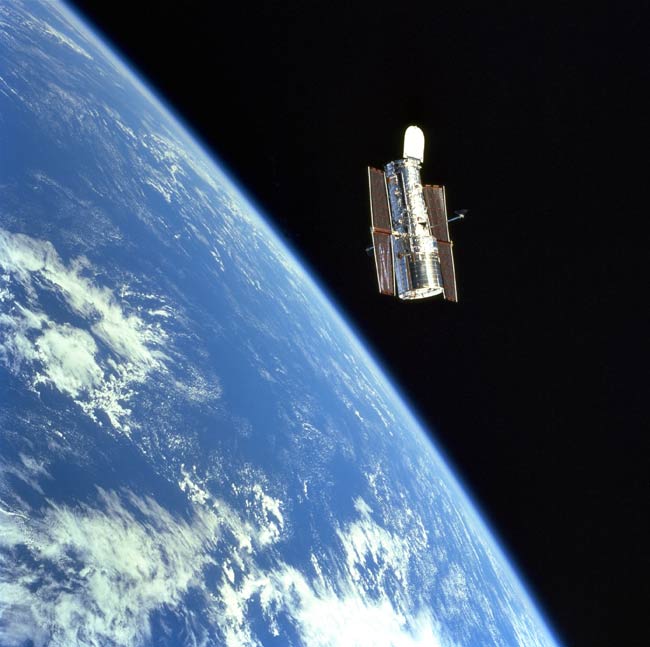Hubble Huggers Ecstatic for Telescope’s Facelift

NEW YORK - It's hard to tell who's more excited for Hubble'supcoming facelift ? the scientists who will benefit from the data the telescopecollects, or the public who will enjoy the pretty pictures.
The aging NASA/ESA (European Space Agency) Hubble SpaceTelescope is set to receive its final upgrade from sevenastronauts due to launch May 11 aboard the space shuttle Atlantis. Whentheir work is completed, the observatory should work betterthan ever and last for at least another five years.
"I'm very excited about it!" said FernandoRibeiro, a Brazilian educator and artist who runs the Web site SaveTheHubble.com."It's what we've been fighting for all these years. I think this is goingto mean a lot both toscience and to the public."
Telescope rally cry
Ribeiro founded his site in 2004 after the shuttle servicingmission, originally scheduled to launch in 2004, was cancelled over safetyconcerns in the wake of the 2003 Columbia disaster. Ribeiro collected some 5,500signatures on a petition to reverse the decision, which would have left Hubblewithout new instruments and repairs needed to keep it alive.
Other Hubble fans (often called "Hubble Huggers")founded similar sites such as SavingHubble.com, which sells Hubble T-shirts.
NASA credits this outpouring of public support for themission as part of the reason it was resuscitated.
Get the Space.com Newsletter
Breaking space news, the latest updates on rocket launches, skywatching events and more!
"I guess they realized that the American society waswilling to foot the bill and take the risk," Ribeiro told SPACE.com."I do believe it is the greatest scientific instrument ever made. HubbleSpace Telescope connects the general public with the infinite wonders of thecosmos and makes us feel part of a bigger universe."
Other supporters use similarly gushing terms to describe theobservatory.
"Telescopes will come and go. Hubble too will one dayend her tour of duty ? but God I LOVE this thing ? this inanimate object hasgiven us images that have been some of the MOST breathtaking, aweinspiring images I have ever seen," wrote commenter"womanspirit" in April 2009 on a message board on the news aggregatorTopix.com.
The people?s telescope
Different theories abound for why this scientific instrumenthas so captivated the public. Obviously, the stunning pictures are hard not tolove. But this telescope has worked its way into people's lives unlike anyother observatory. Perhaps its long working life ? 19 years and counting ? hassomething to do with it.
"When something has that longevity people come of agein the lifetime of the telescope," said Neil deGrasse Tyson, anastrophysicist at the American Museum of Natural History in New York. "Noother telescope can you say that about. It's not only that its making discoveries,taking beautiful pictures, but the serviceability of it has made it a part ofthe American landscape, made it iconic."
Its name recognition also easily beats out most, if not all,other scientific instruments.
"Everyone's heard of the Hubble telescope," Tysontold SPACE.com. "People came to long for the next image that awaitsthem. I can tell you that I don?t know any other field, any other telescope,where the images that it produced did not even require a caption for you tolose yourself in its beauty."
Hubble?s fan club
Hubble images are enjoyable even if you don't know or carewhat a planetary nebula or a dwarf galaxy is. And for those who are curious,the telescope helps provides a visual representation of astronomical objectsthat can be otherwise hard to fathom.
"It provides an image of something that's usuallyabstract," said Lauren Esposito of New York.
Hubble?s cosmic images are so famous that many people canoften name a favoriteHubble photo off the top of their heads. For example, New Yorker NicolasCinquegrani said the image of the Horsehead nebula, with its iconic hose-shapeddark cloud over pink gas, is his favorite.
"Even though I'm not a scientist, I do care" aboutthe fate of the telescope, he said.
And Hubble's need to be repaired and upgraded over the yearsmay even add to its lovability.
Many can date their personal connection to the telescope tothe 1993 shuttle Endeavour rescue mission. Seven astronauts completed difficultand dangerous spacewalks to install hardware to fix a mirror flaw that hadinitially rendered the telescope's pictures fuzzy.
In many people's eyes, the successful repair demonstratedAmerican technological ingenuity, as well as our ability to overcome challengesand turn a tough situation around.
"I think it affects people's sense ofaccomplishment," said Andy Kim of New York.
- New Show: Hubble's Universe: The Final Shuttle Service Call
- Image Gallery - Hubble's Latest Views of the Universe: Part 1, Part 2
- Hubble FAQ: Inside the Last Space Telescope Repair Mission
Join our Space Forums to keep talking space on the latest missions, night sky and more! And if you have a news tip, correction or comment, let us know at: community@space.com.

Clara Moskowitz is a science and space writer who joined the Space.com team in 2008 and served as Assistant Managing Editor from 2011 to 2013. Clara has a bachelor's degree in astronomy and physics from Wesleyan University, and a graduate certificate in science writing from the University of California, Santa Cruz. She covers everything from astronomy to human spaceflight and once aced a NASTAR suborbital spaceflight training program for space missions. Clara is currently Associate Editor of Scientific American. To see her latest project is, follow Clara on Twitter.









